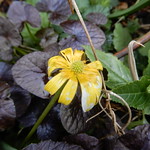Out in the county, as I sometimes am for work, I found myself taking the A4074 in a rattly, filthy, bumpy bus. The windows were thick with winter dirt, the seats were suggestive of potential infestation, and the bus went fast.
The A4074 on google autocompletes with "
bends of death".
Twitter veers between "picturesque but mildly depressing" and "avoid avoid avoid". Wikipedia gives the bus schedule and references a
sound-art project based there, and shares the accident rate (high). On a windy day in early March, three things jumped in at me, through the murky windows and the spitting rain: roadside shrines, dead badgers and drive-by daffodils.


The Crazy Frog roadside shrine caught my eye first. Faded to an unsettling, uniform, brownish-yellow, the mass of crazy frog toys and masks stared blank-eyed across a cavernous ditch into the passing traffic. Then I saw a more standard flower-bunch assemblage around a fatal tree. Then a very serious looking, smart and large cross. The road itself is a run of sprints of variable width and overtakeability, between roundabouts, villages and go-slows. The stop-start-lurch combines with sprint-for-the-horizon moments. Farm traffic and caravans trailing trains of impatience. Sudden squeezes alternating with spaces more broad, but not necessarily less dangerous:


Even without the dead badgers, it was very obviously a hard wall for wildlife. Roads were pallisaded with deep ditches and high banks, verges cut low and creased with traffic damage. Here and there a roadside was clearly used as a walkway, officially or otherwise, advisedly or not, dangerously, sometimes, certainly. People, traffic, a wide and dangerous space. Stock-bridges are rare on small roads like this one, so places with lots of cover become unofficial wildlife crossing spaces, and wildlife dies.
The roundabouts are kept low and high visibility. They're of limited value to animals that can't fly, anyway, but native trees have been planted in any case; silver birch to tempt in the woodpeckers and nuthatches of our future, blackthorn to shelter feeding blue-tits. And here and there, the verges are planted with drive-by daffodils.


Attitudes towards roadside gardening vary, council to council. Some charge for a
planting license, others don't. Some adopt a strongly discouraging tone, others are more participatory about it, some take a firm planning-by-professionals-is-necessary-at-all-stages.
Oxfordshire's approach looks way too scary to consider for a few daffodil bulbs, so my guess is that any daffs that couldn't be explained away as a spillover from a private residence must have come via town or parish council (though that can also mean an enthusiastic individual pushed it through the council of course). At one time, planting Macmillan Daffodil beds was popular, but
not this year - it costs to plant a daffodil bed of course, so maybe it was diverting too much of the funds that would otherwise come to the charity.
Bee-keepers are sniffy about daffodils, too highly bred to be attractive to bees, they say. But bar the rags and triples, I have never grown daffodils without them getting pollinated, so something must like them, and it's not all about the bees.
Vergeside weeds really come into their own a little later in the year, with Cow Parsley, Willowherb, Hogweed and Garlic Mustard, insect platforms of glittering white flowers thick with pollen and nectar, buzzing with hoverflies and crawling with pollen beetles. But at this time of year, the verges are sullen slumps of late-winter sour-grass, covered with a raggedy fuzz of dead brown overgrowth. In the places where primroses and daffodils and celandines stab up through through the grey-green uniformity, it's like a hole punched through to the future that is summer, warm days, air thick with midges and willow-fluff and ringing with birdsong.

Yellow line planting could be given a structure, a species-set. Native Daff, Primrose, Native Celandine, Dandelion, Coltsfoot, Cowslip, Kingcup; there's a YELLOW!!!!! spring flower for every aspect and environment. And while it's true that they move in eventually (some of the best primrose stands I've seen have been on the verges of mature motorways) surely we could help them along a bit, root and bulb and seed and shoot. Just till they're established.























































